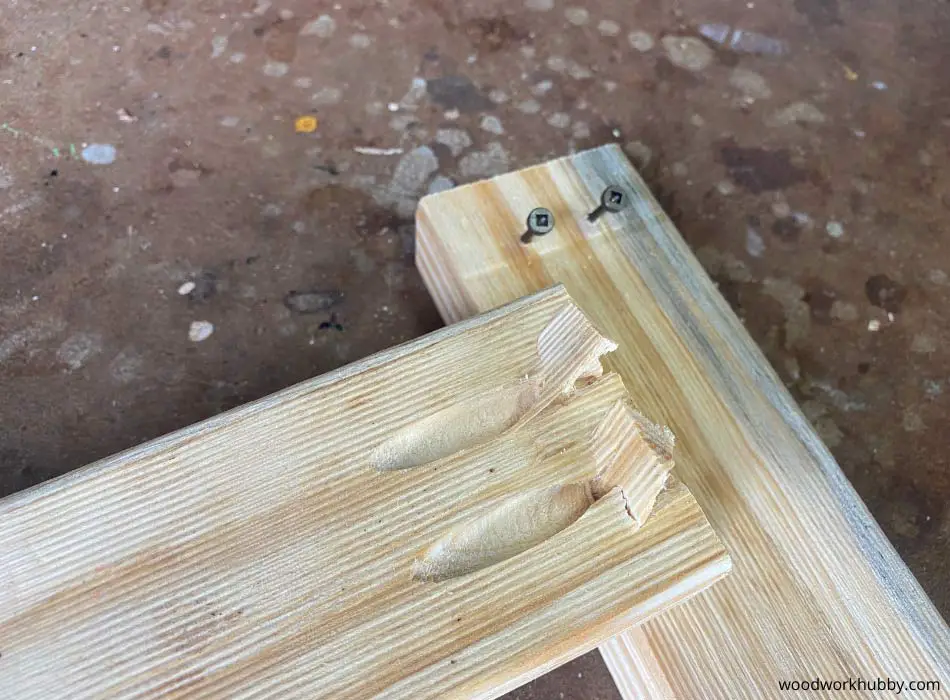Pocket holes certainly seem to be the go-to joint for many beginner and intermediate woodworkers. I recently had to join a frame together and was thinking of using pocket holes but my main concern was, are pocket holes strong? I did some research on them and this is what I found.
On average, pocket hole strength can range from 707 lbs (320kg) to 1361 lbs (617kg) of downward load. Therefore, pocket holes are best for furniture joinery and medium load-bearing projects. But the strength of a specific joint is limited by the wood type, the joint screw size, and the load’s position.
In this article, you will learn about how pocket hole screws’ compatibility with different types of projects alongside their limitations and drawbacks. I have worked with pocket hole joints as well as their alternatives for over 20 years, and I will incorporate my experience in this guide so you can be confident about your choice of joinery. But first, let’s go over how pocket hole joints differ from most other forms of joinery.

| Pocket Hole Material | Fail Weight |
|---|---|
| Oak Wood | 707 lbs (320 kg) |
| Maple Wood | 707 lbs (320 kg) |
| Birch Wood | 705 lbs (319.8 kg) |
| Cedar Wood | 500 lbs (226.8 kg) |
| Drywall | 100 lbs (45.4 kg) |
| Plywood | 90 lbs (40.8 kg) |
| MDF | 50 lbs (22.7 kg) |
A Great Video Showing Pocket Hole Strength
A strength test video between double tenons, screwed and pocket holes.
Some woodworkers hate pocket holes as they believe they are weak and cheap looking. I did some research to find out if this is true. Click on the link to view my article and discover the truth.
Pocket Hole Joints: A Brief Overview
If you’re wondering about the strength of a pocket hole joint, you probably already know what such a joint entails. Here, we will explore how this slanted joint differs from alternative joinery techniques. From dovetails to mortise, dowels to dominoes, you’ll notice that most forms of joinery use a perpendicular angle to build the lifting tension, which maintains the joint.
Pocket holes are lodged at an angle, so the downward or sideways pressure on the joint doesn’t fall on the entirety of the screw. In other words, a pocket hole undergoes less pressure carrying the same amount of weight as an alternative joinery method in corner contexts.
This table elaborates on how pocket holes and other joints vary in strength.
| Joint Type | Average Load-Bearing Strength | Breaking point |
|---|---|---|
| Mortise and tenon joint | 172 lbs (78 kg) | 453 lbs (205 kg) |
| Dowel joint | 135 lbs (61.2 kg) | 345 lbs (156 kg) |
| Dovetail Joint | 540 lbs (244.9 kg) | 1020 lbs (462.7 kg) |
| Pocket Hole Joint | 500 lbs (226.8 kg) | 707 lbs (320.7 kg) |
From here, you can tell that within their respective contexts, pocket hole joints are stronger than mortise and tenon, as well as dowel joints. From the similarities of mortise and dowels to domino joints, one can discern that pocket hole joints are stronger than those as well. Dovetail joints, though, have a much higher load-bearing capacity.
A single pocket hole screw can hold its own against a shearing weight of 500 to 707 lbs (226 to 320 kg)on average.
Some woodworkers might assume that the strongest joint can replace all other types of joinery. It is a novice mistake that I, too, once made. Different joints are ideal for different circumstances. Let’s look at the situations where pocket holes work best.
Are Pocket Holes Strong Enough For Tables?
Pocket hole joints are definitely strong enough for tables as long as you use appropriate screws and the wood around the screw doesn’t give way. Four (4) pocket holes can hold over 1000 lbs (453 kg) of weight on a table. That includes the weight of the tabletop and whatever’s atop the table.
However, pocket hole screws have a very unpleasant way of sticking out if the material they’re being drilled into isn’t thick enough. Unless you’re building an especially thick table, you’re better off using mortise and tenon joints.
Is wood glue strong enough for a tabletop? I did some tests and this is what I found.

Don’t get me wrong. You can definitely get away with using pocket hole joints on a table. But it will look janky. There are other types of projects where pocket hole screws don’t just mess up the appearance but can blow through the material they’re being lodged in.
Are Pocket Holes Strong Enough For Cabinets?
Pocket holes are strong enough for cabinets but are not suitable for cabinetry when the wood boards are thin. Pocket holes can blow through the cabinet wood and render a sheet useless. But if you’re careful and can lodge a small enough screw at the appropriate angle, the joint will hold.
However, I find the best position for pocket hole joinery to be a heavy-duty project with thick wood, well-distributed wood, and little to no decorative exposure. And the first thing that comes to mind when considering those factors is a bed.
A video walk-through showing the steps to build a simple upper wall cabinet.
If your cabinets are made from MDF, be sure to read my other article that explains if you can use pocket holes on MDF?
Are Pocket Holes Strong Enough For A Bed?
Pocket holes are strong enough for a bed as long as they are lodged properly. They can hold 707 lbs (320 kg) of shearing weight. If you had four pocket holes across four corners of the bed, they would collectively carry 2828 lbs (1282 kg) of weight before buckling.
Most importantly, the limitations of pocket hole joints do not apply to a bed. The screws aren’t exposed because the bed frame is thick enough and is covered with plenty of bedding material. The bed has a well-distributed weight across a large enough area for the pocket holes to actually contribute to load-bearing.

The physics of pocket hole strength is worth understanding. A single pocket hole screw can hold its own against a shearing weight of 500 to 707 lbs (226 to 320 kg)on average. This depends on the size of the screw and its material. If it is unconventionally large and with significant teeth, it may carry more than 707 lbs (320 kg).
Pocket Hole Strength And Proximity: A Brief Study
Some might confuse shearing weight with overall weight. Shearing weight is the weight that is directed downward or sideways, forcing the material to slide against itself. The farther a material is from the center of the joint, the harder it is for the joint to carry it. You can see similar physics in carrying a child over your shoulders compared to carrying them in your hands with your arms stretched out.
If you carry someone on your shoulders, all of their weight is shearing weight as it acts downward on you. If you carry the same person with your arms stretched forward, their weight is much harder to manage because it is acting downward on your hands only.
A pocket hole can hold 707 lbs (320 kg)of weight directly over the joint. But since the bed has 4 corners, no single screw can carry 707 lbs (320 kg) of weight unless call corners have pocket hole joints. If the bed frame has multiple pocket hole joints, then there is no need for clamps.
All in all, a pocket hole’s limitations are:
- The material and the size of the pocket hole screw – The larger the screw, the more durable the joint. However, some screws can be too large for specific joints.
- The angle and position at which the screw is lodged – If the screw isn’t lodged properly, the shearing weight might eat through the frame of the bed.
- The presence or absence of other screws – A single pocket hole screw is useless in the context of a bed frame. Other frames are required.
What Are The Disadvantages Of Using Pocket Holes?
The limitations covered earlier are not disadvantages. Those are just a few things you need to keep in mind when using pocket hole joinery, especially in furniture. The actual drawbacks of pocket hole points are as follows:
- Pocket hole joints are notoriously hard to repair – In most projects, a blown pocket hole joint renders a portion of the project wood useless. It is impossible to repair wood if a pocket hole joint is damaged.
- Pocket hole joints are hard to reverse – You can plug pocket hole joints, but the reversal is pretty visible. For projects that are supposed to be decorative, this is a very significant drawback.
- They don’t work on thin wood – If you master only pocket hole joinery, you will find yourself limited to thick wood pieces as thinner ones aren’t conducive to it. Mortise and tenon joints are far more versatile than pocket hole joints.
- Pocket hole joints don’t look good – Although taste is subjective, there seems to be a consensus among woodworkers that pocket hole joints do not look good. This means you cannot use them in places where the screw head is exposed.
When Should You Not Use Pocket Holes?
Now that you know the limitations and the disadvantages of pocket holes alongside their impressive load-bearing strength let’s go over the contexts where you shouldn’t be using pocket holes.
You should not use pocket holes on thin wood sheets, boards that are thinner than half of the screws’ length, and in places where the joint will be visible. The first two reasons have to do with the strength and the integrity of the joint, while the last one is an aesthetic reason.
An additional reason to avoid pocket hole joints is when the wood is weak, and the screw might bite into it, flattening it out eventually. In that specific instance, you’re better off with a dowel or any other right-angle joint alongside a screw anchor that prevents the screw from biting into the wood.
Be sure to check out my article to discover if pocket holes can be used for framing.
Which Is Stronger, Dowels Or Pocket Holes?
Dowels are not stronger than equivalent pocket holes since pocket holes have over 35% higher shear resistance compared to dowel joints as well as against tenons. However, dowels are better for cabinetry and visible joints since they are easier on the eyes.
Dowels can be relatively hard to lodge, especially for beginners, though, and their overall weight-bearing capacity is low. Here are projects in which pocket holes are better than dowels:
- Bed frames – Bed frames need to carry significant weight, for which pocket hole joints’ strength is important.
- Beams – Beams and pillars can be erected with pocket hole screws. You have to use multiple screws, though.
- Framing – Pocketholes are ideal for screws, especially with frame miters. But if the frame is slim, like a photo frame, you might want to use a mortise joint instead.
Pocket holes joinery’s strength makes it the undisputed premiere choice in beds, large frames, and erecting pillars. But remember that A dowel can theoretically be stronger than a pocket hole joint if the size difference is significant enough.
The orientation of pocket hole joints does matter. But what matters more is the size of the screw. If a pocket hole screw is too big, it blows apart the wood. And if it is too small, it cannot bear the weight it is supposed to carry.
How Much Weight Can Pocket Screws Hold?
Pocket screws can hold 300 lbs to 707 lbs (136 to 320 kg)depending upon the size of the screw. Smaller pocket holes can collectively carry over 1000 lbs (453 kg) in a cabinet. However, the wood’s shear threshold is weaker, and it buckles before the joint is dislodged.
The fail weight of a pocket hole screw isn’t contingent just on the screw’s size but the material in which it is lodged. You can refer to this table to see if you should use a pocket hole joint in a specific context.
Which Joint Is Stronger Than Pocket Holes?
Dowels and tenons are not stronger than pocket hole joints despite being neighbors in terms of application. A widely different type of joint, the Dovetail, is much stronger than a pocket hole joint. It is also a lot more predictable.
Dovetail joints require wood-cutting mastery. If these joints aren’t tight enough, they are useless. Despite being stronger than pocket holes, they don’t replace the slanted joints. That’s why I mentioned earlier that the strength of the joint is not the only factor that dictates its compatibility with a project.
In a bed, the dovetail joints can fix the side wood with the head or footboard wood. But when it comes to holding up the platform, nothing will be as effective as a pocket hole joint. Similarly, slanted applications like crown molding benefit from pocket hole joints. Many of these applications don’t lend themselves to pocket holes.
Check out my article about spackling on wood joints here.
Should I Use Pocket Holes?
You should use pocket holes if a project is meant to bear a load and its wood is not thin. If you use pocket holes in your cabinet projects, make sure that the pocket hole joints are on the inside. Use mortise and tenon joints or dowels on the outside, though.
Pocket Hole Jigs Which I Use
| Recommended Pocket Hole Jigs | Where to Buy? |
|---|---|
| Massca Pocket Hole Jig | AMAZON |
| HOWOD Pocket Hole Jig Kit, Professional and Upgraded All-Metal Pocket Screw Jig | AMAZON |
Final Thoughts – Are Pocket Holes Strong?
Pocket Hole joints are among the strongest forms of joinery. But since they do not look good and can blow through thin wood, they are not as universal as mortise and tenon joints or dowels. For best results, you should use pocket holes for load-bearing joints and in tough wood that won’t buckle easily.






